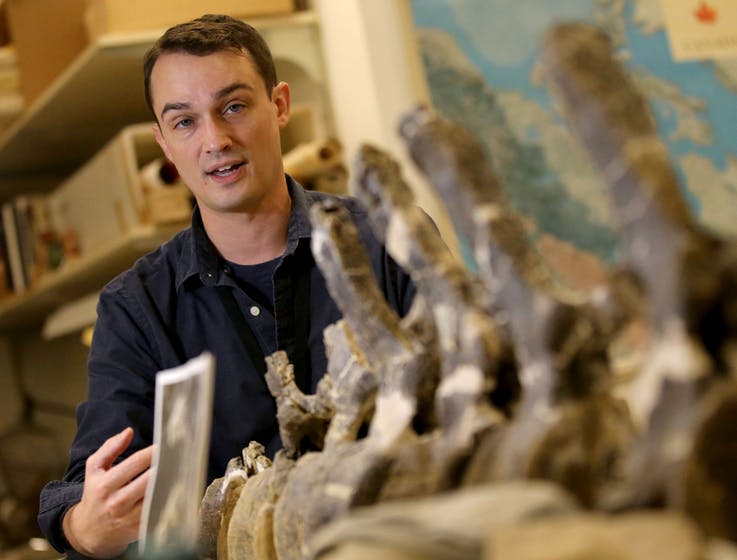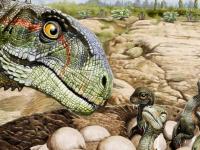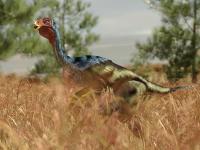Meet the New Dinosaur Bone Hunter at the Science Museum of Minnesota

The Science Museum's new paleontologist really digs crocodiles and "Jurassic Park."
Alex Hastings studies beasts that sound like they come from monster movies: a crocodile agile enough to hunt horses, a snake as long as a school bus.
Happily, those creatures are long extinct, but Hastings can tell you all about them as the new expert on dinosaurs and fossils for the Science Museum of Minnesota.
Hastings, 35, is the St. Paul museum’s new Fitzpatrick Chair of Paleontology, taking over from Bruce Erickson, who recently retired after 58 years on the job.
Formerly the assistant curator of paleontology at the Virginia Museum of Natural History, the Vermont native moved to Minnesota with his wife, newborn son, three cats, two dogs, two lizards and a snake (the ball python, named Nagini, is much smaller than a school bus, but is still a substantial 3 ½ feet long).
A Ph.D. who likes comic books, Hastings is a specialist in prehistoric crocodiles and a fan of a certain movie about dinosaurs brought back to life through cloning.
Q: How long have you been interested in dinosaurs?
A: I’ve been on this path as long as I have memory, basically. It’s definitely my life’s passion. I was very much the little kid that was just enthralled by dinosaurs. And, basically, I just didn’t grow up. As long as I can remember, knowing that it was a possibility to pursue this as a career, I’ve been pursuing that.
Q: A lot of kids like dinosaurs. Any particular thing that kept you at it?
A: To be honest, the movie release of “Jurassic Park” in 1993. I was definitely very much geeked out on dinosaurs. I was pretty much on this career path anyway, but if I was ever going to waver, that movie just derailed any other possible notion of doing anything else.
Q: How did you get interested in prehistoric crocodiles?
A: They’re really amazing, fascinating animals. I can stare at them for hours and hours and hours. They are one of nature’s longest surviving groups. They have a record that goes over 240 million years.
When you go into that massive record, you find some really bizarre ones where they really branched out from this typical ambush predator in the water. I did my post-doc on a land hunting crocodile in Germany about 48 million years ago that was likely hunting down horses, which is just something we don’t have alive today.
Q: What was the biggest find you’ve been involved in as a paleontologist?
A: As a grad student, I was lucky enough to be one of the people who can claim at least partial discovery of Titanoboa, which is the largest snake that ever lived. It was about 42 feet long and weighed 1¼ tons and lived 60 million years ago in South America. It is a relative of the anacondas. It’s the biggest by far in terms of both length and mass.
Q: Did discovering the Titanoboa lead to other insights?
A: We worked out that the minimum temperature needed to keep a snake of that size alive — you’re looking at a temperature in the tropics that’s significantly higher than today. It’s very important for climate prediction and future models to understand how climate change will impact tropical environments.
At the time there had been a few ideas that the tropics would be relatively buffered from temperature increases globally, that it would affect temperate and polar regions dramatically, but not so dramatically in the tropics. This countered that entirely. You can absolutely turn up the thermostat in the tropics, and there’s absolutely every potential to do that in the future.
Q: So if it gets hotter, we’ll get bigger snakes in the tropics. Anything else?
A: Interestingly, heat affects where you can have big snakes. And there’s already records of the invasive Burmese pythons in Florida getting further and further north as time goes by. It’s not necessarily saying we will immediately get these massive snakes, but it lifts the bar on what’s possible.
Q: How many times have you been asked if “Jurassic Park” could really happen?”
A: I do get asked that a lot. Short answer is no. Fantastic movie. I absolutely loved it. Great science fiction.
The whole premise is being able to get dinosaur DNA from mosquitoes preserved in amber. Big problem with that is the second that dinosaur blood gets into the mosquito’s stomach, the digestive acids break up the DNA completely.
DNA degrades after about 50,000 years, and dinosaurs are millions and millions of years old. So the odds of getting any genetic information by any means are astonishingly low. In terms of cloning dinosaurs, I don’t see how that’s ever going to be possible. But it would be cool.
Q: So we’ll never see a velociraptor brought back to life?
A: What you do have, though, is DNA from the last ice age. If you wanted to start cloning ancient creatures, things like mammoths and saber tooth cats are much more in the realm of possibility. There are still all kinds of complications that go into that, but it’s something that — certainly not anytime soon, but maybe sometime long in the future — might actually be possible.
Q: What do you think of the de-extinction projects, being worked on by some scientists, which would use genetic engineering to devise creatures that would look and act like a passenger pigeon or a woolly mammoth or a dodo?
A: Basically you’re mutating something that exists into your perception of another thing. So what you’re creating is never going to be the same. You’re putting your own biases into it. You’re not really making a discovery in that sense.
When you’re cloning something, if it turns out it has feathers and you didn’t realize that, then that’s new information. If you’re trying to mutate a chicken into a T. rex or something, you’re going to be mutating it based on the things that you’ve seen in the bones, but you’re not creating a T. rex. You’re just creating a highly mutated chicken, basically. Which could still be cool and interesting to look at, but it’s not giving you a new discovery.
Q: Do you think it’s a good idea for someone to say, “Here’s passenger pigeon 2.0, a new version of this creature we killed off 100 years ago?”
A: Once you remove something from the ecosystem, it tends to find a new norm. More or less, you end up being unable to reset the clock. Once it’s done, it’s kind of done. If you want to make these new changes by bringing something back, realize you’re not going to get back to where you were before.
Source: www.startribune.com








